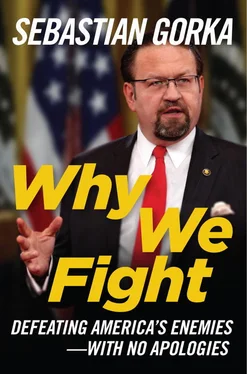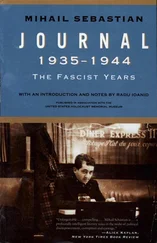Sebastian Gorka - Why We Fight - Why We Fight - Defeating America's Enemies - With No Apologies
Здесь есть возможность читать онлайн «Sebastian Gorka - Why We Fight - Why We Fight - Defeating America's Enemies - With No Apologies» весь текст электронной книги совершенно бесплатно (целиком полную версию без сокращений). В некоторых случаях можно слушать аудио, скачать через торрент в формате fb2 и присутствует краткое содержание. Город: Washington, Год выпуска: 2018, ISBN: 2018, Издательство: Regnery Publishing, Жанр: Политика, Публицистика, на английском языке. Описание произведения, (предисловие) а так же отзывы посетителей доступны на портале библиотеки ЛибКат.
- Название:Why We Fight: Why We Fight: Defeating America's Enemies - With No Apologies
- Автор:
- Издательство:Regnery Publishing
- Жанр:
- Год:2018
- Город:Washington
- ISBN:978-1-62157-640-2
- Рейтинг книги:5 / 5. Голосов: 1
-
Избранное:Добавить в избранное
- Отзывы:
-
Ваша оценка:
- 100
- 1
- 2
- 3
- 4
- 5
Why We Fight: Why We Fight: Defeating America's Enemies - With No Apologies: краткое содержание, описание и аннотация
Предлагаем к чтению аннотацию, описание, краткое содержание или предисловие (зависит от того, что написал сам автор книги «Why We Fight: Why We Fight: Defeating America's Enemies - With No Apologies»). Если вы не нашли необходимую информацию о книге — напишите в комментариях, мы постараемся отыскать её.
Why We Fight: Why We Fight: Defeating America's Enemies - With No Apologies — читать онлайн бесплатно полную книгу (весь текст) целиком
Ниже представлен текст книги, разбитый по страницам. Система сохранения места последней прочитанной страницы, позволяет с удобством читать онлайн бесплатно книгу «Why We Fight: Why We Fight: Defeating America's Enemies - With No Apologies», без необходимости каждый раз заново искать на чём Вы остановились. Поставьте закладку, и сможете в любой момент перейти на страницу, на которой закончили чтение.
Интервал:
Закладка:
Most importantly, Truman directly connected the fate of those threatened by communist takeover to the the safety of America:
We shall not realize our objectives, however, unless we are willing to help free people maintain their free institutions and national integrity against aggressive movements that seek to impose totalitarian regimes upon them. This is no more than a frank recognition that totalitarian regimes imposed on free peoples, by direct or indirect aggression, undermine the foundations of international peace and hence the security of the United States.
Finally the president concluded that US policy must support those prepared to fight against the spread of communism:
I believe that it must be the policy of the United States to support free peoples who are resisting attempted subjugation by armed minorities or by outside pressures.
The free peoples of the world look to us for support in maintaining their freedoms.
If we falter in our leadership, we may endanger the peace of the world—and we shall surely endanger the welfare of our own nation. [1] You can listen to the original audio of President Truman’s declaration at http://www.americanrhetoric.com/speeches/harrystrumantrumandoctrine.html .
This vision of assisting those who would resist the spread of communism around the world became known as the Truman Doctrine, and later as “containment policy.” It led Truman and other US presidents, both Democrat and Republican, to support anti-communist movements and forces. Seeking to contain Soviet influence and the ideology of Marx and Lenin, American administrations often looked favorably upon—and at times facilitated—regimes that were less than democratic. Whether in Argentina or Iran, right-wing military regimes and other authoritarian governments were deemed as lesser evils compared with the globally ambitious dictators in the Kremlin.
In response to the the threat of communist expansionism, America helped form the North Atlantic Treaty Organization (NATO) and the Southeast Asia Treaty Organization (SEATO) to tie her allies and partners together in defensive relations that would strengthen their collective ability to protect themselves against Soviet attack. Containment, however, didn’t help Afghanistan in 1979.
An unusual country comprising dozens of “nations” with dozens of indigenous languages, Afghanistan has been dubbed the “graveyard of empires,” having over the centuries severely challenged the ambitions of imperial forces from Alexander the Great to the British Empire. Nevertheless, when the Kremlin deemed the socialist government in Kabul that had replaced the Afghan monarchy not “socialist enough,” it decided to use its superpower military to make Afghanistan just one more of its enslaved satellite states.
After assassinating the Afghan president in December 1979, the Soviets sent eighty thousand troops, almost two thousand tanks, and as many armored personnel carriers to invade Afghanistan. It was now clear that America’s containment policy had dramatically failed. The brand new Reagan administration decided that diplomacy and sanctions were not an adequate response to the emboldened and increasingly aggressive USSR. After authorizing a major covert operation, Reagan launched Operation Cyclone. This operation was co-funded by the kingdom of Saudi Arabia, run with the Pakistani intelligence service, and used weapons purchased from China and Europe to provide sustained support to the indigenous Afghan fighters in their resistance to their Soviet occupiers.
In addition to arming and directly supporting the fight against communism’s spread into the region, the Reagan administration increased defense spending in general. The goal was not simply to achieve military superiority over the USSR, but also to place an increasing financial and economic stress on the creaking command economy of the Marxist state. The new investment in America’s defenses went to personnel and established weapons systems and new technologies that would challenge Moscow’s capability to compete, let alone catch up, with America militarily.
The most famous of these new technologies was the Strategic Defense Initiative (SDI), the missile-defense system that Reagan’s critics derisively labelled “Star Wars.” SDI was an effort to assemble a system that could intercept and destroy Soviet nuclear-armed missiles in flight, obviating any Soviet plan for a preemptive strike against America and the West.
Its detractors ridiculed the system as a pipe dream, but the politburo in Moscow took it very seriously indeed. General Secretary Mikhail Gorbachov abruptly ended his nuclear arms negotiations with President Reagan at Reykjavik in 1986 rather than accede to further US research on SDI. That research would later spur significant advances in sensor technology, lasers, and such cutting-edge weapons as the future “railgun” platform.
Perhaps the least appreciated of the Reagan era responses to the increased aggression of the Soviet Union are the non-physical ones. In 1977, former Governor Reagan, preparing for another run at the White House in 1980, remarked to Richard Allen, his future national security advisor, “My theory of the Cold War is we win and they lose.” Reagan was not thinking of winning a “hot” war with the USSR, but an ideological war. It would be necessary for the United States to deploy non-kinetic means to demonstrate the moral and economic bankruptcy of the Soviet regime.
After the giant covert mission in Afghanistan, increased defense spending, and the development of defensive technologies that made Russian strategic advances irrelevant, the Reagan administration turned aggressively to the “war of ideas.” What we did then as a nation is of great relevance today as we face post-Cold War adversaries who know they cannot defeat us militarily but are conducting information operations and trying to subvert us in unconventional ways.
As George Kennan’s Long Telegram and the Truman Doctrine recognized, the enemy’s ideology was fundamentally illegitimate. Under the communist system, the wishes of the people did not matter. Only one party could exist, and the Communist Party elite held the monopoly on power and “truth.” Any dissension with the party would lead to persecution, labor camps, or execution. Yet at the same time, the Soviet Union and her frontmen and agents in other “captive nations” continually preached equality, peace, and justice. Reagan understood that the gulf between communism’s depiction of reality and the plain truth was the enemy’s greatest vulnerability. The Kremlin preached equality for all in a classless society, yet there was obviously a tiny elite for whom all luxuries were available whilst the majority stood in line for hours to buy the staples of life. Shining a light on that disparity would illuminate the bankruptcy of the Soviet “narrative.”
At international conferences and diplomatic engagements, sundry high officials of the Soviet bloc spoke endlessly of human rights and peaceful coexistence. Meanwhile, their citizens were tortured and imprisoned for their beliefs, and Soviet “allies” such as Hungary, Czechoslovakia, and most recently Afghanistan, were invaded because they did not obey the diktats of the Kremlin. Just nine years after Reagan assumed the presidency, a strategic American counteroffensive targeting these contradictions would help bring the whole dictatorship down without bombers or tank divisions.
This non-physical counteroffensive worked at various levels. At the highest were the top-secret presidential directives that outlined the plan to discredit the Kremlin, demonstrate the injustice of the communist regimes, and reinforce the nascent pro-democracy forces behind the Iron Curtain, especially the Solidarity trade union movement in Poland. These covert measures were complemented by the president’s speeches undermining the prestige and power of the communist elite, most famously his “evil empire” address and his dramatic entreaty in front of the Brandenburg Gate in Berlin: “Mr. Gorbachev, tear down this wall!”
Читать дальшеИнтервал:
Закладка:
Похожие книги на «Why We Fight: Why We Fight: Defeating America's Enemies - With No Apologies»
Представляем Вашему вниманию похожие книги на «Why We Fight: Why We Fight: Defeating America's Enemies - With No Apologies» списком для выбора. Мы отобрали схожую по названию и смыслу литературу в надежде предоставить читателям больше вариантов отыскать новые, интересные, ещё непрочитанные произведения.
Обсуждение, отзывы о книге «Why We Fight: Why We Fight: Defeating America's Enemies - With No Apologies» и просто собственные мнения читателей. Оставьте ваши комментарии, напишите, что Вы думаете о произведении, его смысле или главных героях. Укажите что конкретно понравилось, а что нет, и почему Вы так считаете.












